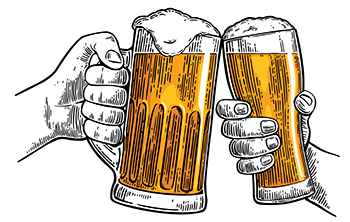By Hon. Earl G. Penrod, Senior Judge & Indiana Judicial Outreach Liasion | Indiana Criminal Justice Institute
“Not drunk is he who from the floor can rise alone and still drink more…”
—Thomas Love Peacock

Judges who preside over impaired driving cases quickly learn that the most common number of beers/drinks consumed by drunk driving defendants is two. Even though blood alcohol concentration (BAC) results may range from .08% to .38%, numerous defendants claim to have consumed two beers, whether defending against or admitting to the charge.
Although reasons for the two beers assertion are less than certain, one explanation may be that it permits the person to acknowledge conduct but minimize the criminal nature of the activity. Indicative of the attitude that drunk driving isn’t really criminal conduct, claiming two beers is another way to claim that it isn’t illegal to drink and drive, it is only illegal to drink TOO MUCH and drive—that is, falling down, throwing-up drunk.
In spite of the refusal of some to recognize the dangers and criminality of impaired driving, efforts since the 1970s to combat the issue have been met with some success. The Foundation for Advancing Alcohol Responsibility (responsibility.org) reports that fatalities in drunk driving crashes have fallen by 48% since 1982. The picture is improving, but almost 30 people still die every day in this country in drunk driving crashes: one fatality every 48 minutes.
Indiana is not immune from the carnage on the highways; in 2017 there were 220 alcohol impaired driving deaths and 914 traffic fatalities. For context, the Centers for Disease Control and Prevention report that in 2017, there were 456 murders in Indiana. With the rate of traffic fatalities twice that of the murder rate, how is it that risk-taking behaviors on the highways remain acceptable or are minimized?
Effects of Alcohol
Because alcohol-impaired driving has been a public safety issue for decades, extensive research has been conducted on the effects of alcohol on a person’s ability to drive. There is a plethora of data demonstrating a direct correlation between BAC and impairment: the higher the BAC, the greater the impairment.
Even a small amount of alcohol has an impact on driving ability, although impairment is sufficiently pronounced at a BAC of .08%. All states have enacted laws that make it illegal to drive with a BAC of .08% or more. While the .08% BAC per se offense precludes the argument about whether someone is impaired at .08% BAC, an unintended consequence of such laws is that some now argue that any BAC below .08% is a passing score. IC 9-13-2-151, which provides that a BAC from .05% to .08% is relevant evidence of intoxication, is usually ignored.
With a BAC of .05% an individual will have reduced coordination, difficulty steering, and a reduced response to emergency driving situations. Studies have shown that a person with a BAC of .05% is twice as likely to be in a crash. Some advocacy groups and traffic safety entities, such as the National Transportation Safety Board, support lowering BAC limits from .08% to .05%. Utah became the first state to adopt the BAC limit of .05%, effective January 1, 2019.
Public Awareness
A variety of risk-taking behaviors including speeding, distracted driving, drugged driving, drowsy driving, and failing to wear seat belts are responsible for traffic fatalities. But drunk driving remains responsible for a higher percentage of traffic crashes in spite of persistent efforts to address the problem. The AAA Foundation for Public Safety’s Traffic Safety Culture Index reports that the public is generally aware of the seriousness of drunk driving as 74.4% of those surveyed indicated driving after drinking is completely unacceptable; 19.3% found it somewhat unacceptable; and only 5.8% considered driving after drinking alcohol to be acceptable. However, among those who reported consuming alcohol, 20.7% reported that within the past year, they had driven when they thought they had consumed too much alcohol to safely drive. As with many social ills, some are willing to hold others to a behavioral standard different than the standard for themselves. That is, drunk driving is completely unacceptable … when others do it.
Proper Adjudication and Evidence-Based Sentencing
Nothing in this column is to suggest that all persons charged with drunk driving are guilty, or that impaired driving defendants are not entitled to due process. Indeed, regardless of the fatalities, injuries, and social costs caused by impaired drivers, judges must afford defendants all procedural safeguards and legal protections. But criminal justice system stakeholders, including judges, also must not minimize the seriousness of impaired driving, and it is incumbent on the criminal justice system to properly adjudicate impaired driving cases and implement evidence-based sentencing options that reduce recidivism and enhance public safety. Some of those evidence-based sentencing practices will be addressed in upcoming columns.
 For additional information on this topic, please contact the author at
For additional information on this topic, please contact the author at